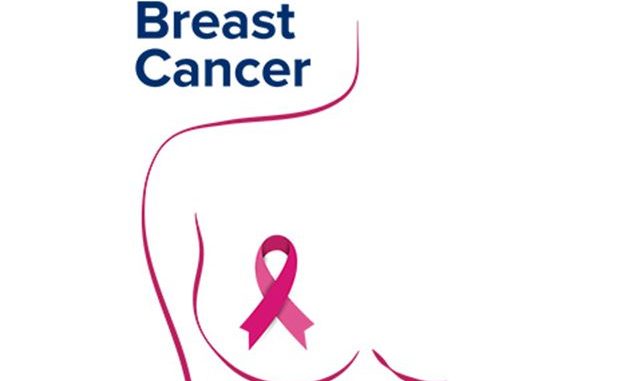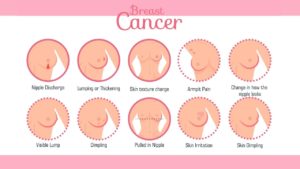
Table of Contents
What is Breast Cancer?
- Breast cancer is a condition in which the body’s cells develop and enlarge out of control, resulting in a mass of tissue known as a tumor.
- Breast cancer may begin in either the left or right breast. Breast cancer originates in the lining cells (epithelium) of either the ducts (85%) or lobules (15%) within the glandular tissue of the breast.
- The cancerous development is initially contained within the duct or lobule (“in situ”), where it often exhibits no symptoms and has a low risk of metastasizing.
- These in situ (stage 0) tumors may develop over time and migrate to the lymph nodes nearby (regional metastasis), other body organs (distant metastasis), or invade the breast tissue immediately around them (invasive breast cancer).
Key Facts
- Breast cancer is the cancer that affects women most frequently and is highly prevalent among women.
- The most common cancer in the globe as of the end of 2020 was breast cancer, which had been diagnosed in 7.8 million women in the five years prior to that.
- Breast cancer causes a greater burden of disability-adjusted life years (DALYs) for women worldwide than any other form of cancer.
- Every country in the world experiences breast cancer in women after puberty at any age, although the incidence rates rise as people age.
- Between the 1930s and the 1970s, there were very minor changes in breast cancer mortality.
- In nations with early detection programs coupled with various forms of treatment to remove invasive disease, improvements in survival started in the 1980s.
Types of Breast Cancer
Breast cancer can be one of the following, depending on its ability to spread within the body and attack organs and tissue away from its site of origin:
1. Non-invasive
- Non-invasive (or in situ) means it doesn’t invade the surrounding breast tissue and remains contained to the region of the breast where it first appeared.
Ductal carcinoma in situ (DCIS)
- Precancer, or a condition that affects the breast and has the potential to develop into cancer, is known as ductal carcinoma in situ (DCIS).
- As its name implies, it begins in a milk duct (ductal) and is still at its initial location within the breast tissue.
2. Invasive
- When a tumor may spread through the blood and lymphatic system and eventually impair essential bodily systems, it is invasive.
Invasive ductal carcinoma
- The abnormal breast cells in this type of breast cancer start out in the ducts before spreading to other areas of the breast tissue.
- These invasive duct cells can later metastasis, or spread to other bodily areas.
- In other words, an individual’s bones, lungs, brain, or liver may have abnormal duct cells.
Invasive lobular carcinoma
- The lobules are where invasive lobular carcinomas start, then the adjacent breast tissue is affected.
- These invasive cancer cells have the capacity to spread to other body organs.
Causes of Breast Cancer
- We have no way of knowing what develops breast cancer.
- Currently, there is no conclusive identification of specific causes for breast cancer.
- Environmental, lifestyle, and hormonal factors that may raise the risk of breast cancer have been found by researchers.
- However, it is unclear why some people with risk factors never get cancer while others with risk factors do.
- The development of breast cancer is likely influenced by a complex interplay between environmental factors and genetic composition.
Risk Factors
1. Modifiable risk factors
- Lack of physical activity increases a woman’s risk of developing breast cancer.
- Compared to older women who are at a healthy weight, those who are overweight or obese have an increased risk of developing breast cancer.
- Prolonged usage of hormone replacement therapies containing both progesterone and estrogen during menopause, lasting more than five years, may raise the risk of breast cancer.
- It has also been discovered that several oral contraceptives increase the risk of breast cancer.
- Factors such as never having a full-term pregnancy, first pregnancy occurring after the age of 30, and not breastfeeding can increase the risk of breast cancer.
- Research suggests that as alcohol consumption increases, so does a woman’s risk of developing breast cancer.
2. Non-modifiable risk factors
Getting older
- Age raises the risk of breast cancer. Most cases of breast cancer are detected after the age of 50.
Genetic mutations
- Breast and ovarian cancer risk is increased in women who have hereditary changes (mutations) to specific genes, such as BRCA1 and BRCA2.
Reproductive history
- Beginning menstruation before the age of 12 and beginning menopause after the age of 55 expose women to hormones for a longer length of time, increasing their risk of breast cancer.
Having dense breasts
- As connective tissue predominates over fatty tissue in dense breasts, tumors may occasionally be difficult to detect on a mammography.
- Breast cancer is more likely to affect women who have dense breasts.
Having a personal history of breast cancer or certain non-cancerous breast conditions
- Women who have previously experienced breast cancer are at a higher likelihood of recurrence.
Family history of breast or ovarian cancer
- If a woman has a mother, sister, or daughter (first-degree relative) or numerous family members on either her mother’s or father’s side of the family who have had breast or ovarian cancer, her risk of developing breast cancer increases.
Previous radiation therapy treatment
- Breast cancer is more likely to develop in older women who received radiation therapy to the chest or breasts before the age of 30.
High Risk Groups
- Strong family history of breast cancer or inherited changes in BRCA1 and BRCA2 genes has a high risk of getting breast cancer.
Signs and Symptoms of Breast Cancer
- Alteration in the size or shape of either one or both breasts
- Release of fluid from either nipple, potentially containing streaks of blood
- Lump or swelling in each armpit
- Indentations or puckering on the skin covering the
- Development of a rash surrounding or on the nipple
- Transformation in the appearance of the nipple, such as it sinking inward into the breast
Stages of Breast Cancer
Stage 0
- The disease has no invasiveness. This indicates that it hasn’t erupted from breast ducts.
Stage 1
- Cancer cells in stage 1 have already infiltrated adjacent breast tissue.
Stage 2
- The tumor is either smaller than 2 centimeters in diameter and has spread to the lymph nodes under the arms, or it is greater than 5 centimeters in diameter but hasn’t done so.
- At this stage, tumors may or may not impact the adjacent lymph nodes and range in size from 2 to 5 cm.
Stage 3
- At this stage, the cancer has already spread beyond its initial location.
- It may have extended to nearby lymph nodes and tissue, but it has not reached distant organs.
- Breast cancer at stage III is typically referred to as locally progress.
Stage 4
- The cancer has progressed to organs other than the breast, including the bones, liver, lungs, and brain
- Stage IV breast cancer is also referred to as metastatic breast cancer.
Screening
- Mammography is the most common screening method used for breast
- Women with a high risk of breast cancer may be screened using magnetic resonance imaging (MRI).
- Clinical trials have examined or are evaluating additional screening procedures:
-
- Breast Exam
- Thermography
- Tissue sampling
Diagnosis of Breast Cancer
- Breast exam
- Mammogram
- Breast ultrasound
- Biopsy
Breast Self-examination
Step 1: Observe your breasts in a mirror with your hands on your hips
Step 2: Raise your arms and inspect your breasts
Step 3: Check for any signs of breast fluid
Step 4: Feel for any lumps in the breasts while lying down
Step 5: Feel Your Breasts for Lumps While Standing or Sitting
Source: https://www.breastcancer.org/screening-testing/breast-self-exam-bse
Prevention
- Limit your alcohol consumption.
- Keep a healthy weight.
- Physical activity can assist in maintaining a healthy weight, which can aid in the prevention of breast cancer.
- Breastfeeding may contribute to the prevention of breast cancer.
- Limit postmenopausal hormone therapy since breast cancer risk may rise with combined hormone therapy.
Treatment
Surgery
- A medical procedure where doctors remove cancerous tissue
Chemotherapy
- Use of specific drugs to reduce or eradicate cancer cells.
- The drugs can be taken orally, delivered intravenously, or sometimes a combination of both.
Hormone treatment
- Prevents hormones, which are necessary for the growth of cancer cells, from reaching them.
Biological treatment
- Works in conjunction with your body’s immune system to combat cancer cells or manage the adverse effects of other cancer treatments.
Radiation treatment
- Elimination of cancer cells through the use of high-energy beams similar to X-rays.
Fatality rate
- A woman’s likelihood of dying from breast cancer is roughly 1 in 39 (about 2.5%).
References and For More Information
https://www.who.int/news-room/fact-sheets/detail/breast-cancer
https://www.cdc.gov/cancer/breast/basic_info/symptoms.htm
https://4rai.com/blog/understanding-the-different-types-of-breast-cancer
https://www.cancer.org/cancer/types/breast-cancer/about/types-of-breast-cancer.html
https://www.cancer.net/cancer-types/breast-cancer/symptoms-and-signs
https://www.wcrf.org/cancer-trends/breast-cancer-statistics/
https://www.mayoclinic.org/diseases-conditions/breast-cancer/symptoms-causes/syc-20352470
https://my.clevelandclinic.org/health/diseases/3986-breast-cancer
https://www.nhs.uk/conditions/breast-cancer/
https://www.cancer.gov/types/breast
